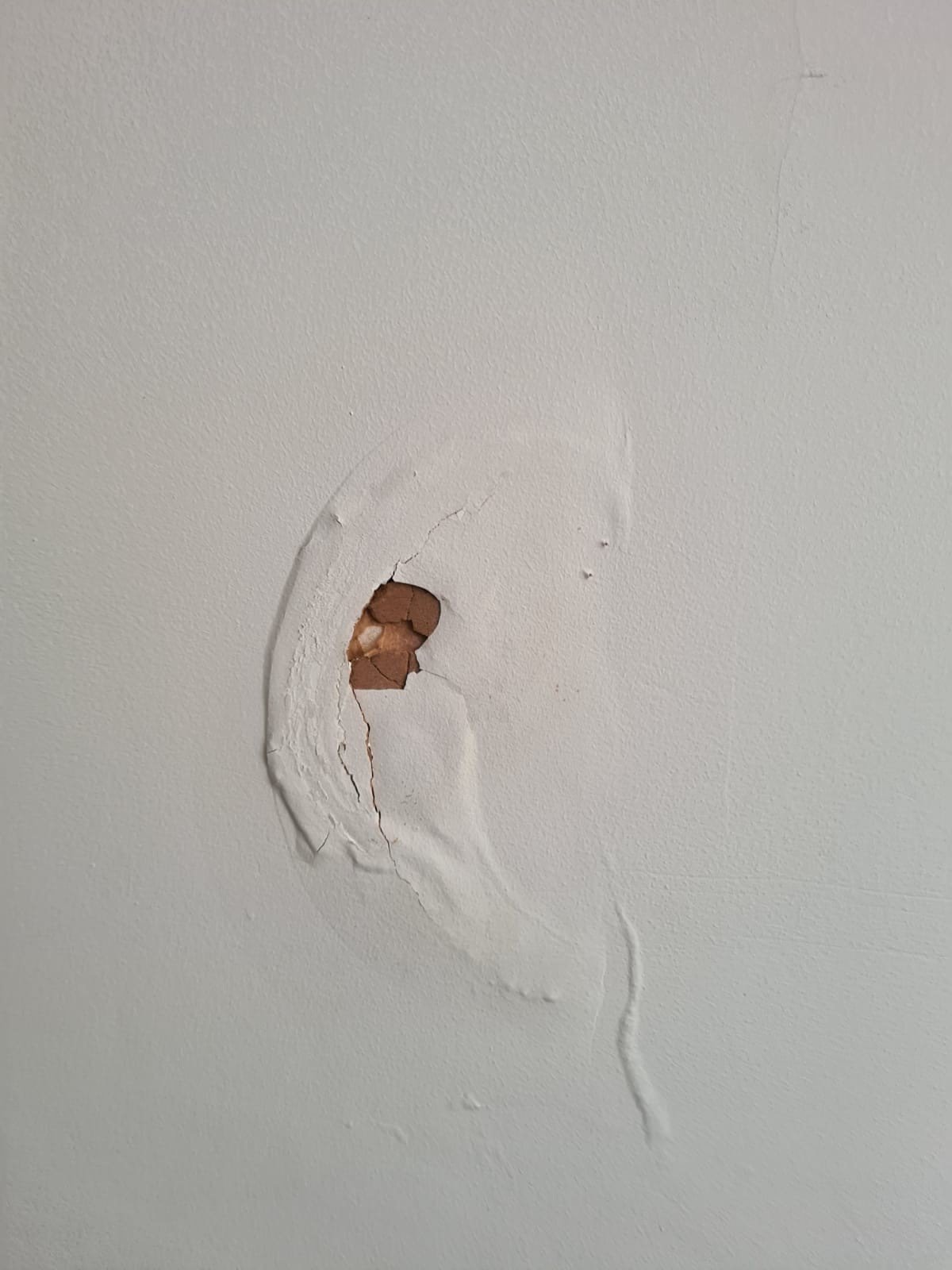We’d like to remind Forumites to please avoid political debate on the Forum.
This is to keep it a safe and useful space for MoneySaving discussions. Threads that are – or become – political in nature may be removed in line with the Forum’s rules. Thank you for your understanding.
The MSE Forum Team would like to wish you all a Merry Christmas. However, we know this time of year can be difficult for some. If you're struggling during the festive period, here's a list of organisations that might be able to help
📨 Have you signed up to the Forum's new Email Digest yet? Get a selection of trending threads sent straight to your inbox daily, weekly or monthly!
Leak in my leasehold flat
chumph
Posts: 4 Newbie


Hi there,
I just recently had an initial assessment from a damp specialist on my leasehold flat after detecting a damp spot on a wall in my flat. The outcome assessment was I require trace and access to locate a leaking pipe that is causing dampness to the party wall of the living area and bathroom area. I am in the ground floor flat and this party wall runs the length of the building (3 floors up). The access and trace within my flat requires the removal of tiles and stripping out sections of dry lining.
As a leaseholder, I have only been able to take out contents insurance and I am unable to get buildings insurance. Buildings insurance is included as part of my service charge and it does state it covers trace and access and escape of water. However, per my lease it states that I am responsible for repairs to flat including; internal non-structural walls, the plastered coverings, the plaster work of the external and other load bearing walls and partitions, and all conduits (i.e. pipes, wires, cables, etc) which serve my flat only. Whereas anything that forms part of the main structure is the responsibility of the landlord which I bear a proportion of the cost.
I am very worried that I am not covered for this repair work... but more worryingly, I never could of been. The leak could be coming from the flat above, however it is just as likely (perhaps more so) that its coming from within my flat.
Does anyone have any advice on what I should do.
I just recently had an initial assessment from a damp specialist on my leasehold flat after detecting a damp spot on a wall in my flat. The outcome assessment was I require trace and access to locate a leaking pipe that is causing dampness to the party wall of the living area and bathroom area. I am in the ground floor flat and this party wall runs the length of the building (3 floors up). The access and trace within my flat requires the removal of tiles and stripping out sections of dry lining.
As a leaseholder, I have only been able to take out contents insurance and I am unable to get buildings insurance. Buildings insurance is included as part of my service charge and it does state it covers trace and access and escape of water. However, per my lease it states that I am responsible for repairs to flat including; internal non-structural walls, the plastered coverings, the plaster work of the external and other load bearing walls and partitions, and all conduits (i.e. pipes, wires, cables, etc) which serve my flat only. Whereas anything that forms part of the main structure is the responsibility of the landlord which I bear a proportion of the cost.
I am very worried that I am not covered for this repair work... but more worryingly, I never could of been. The leak could be coming from the flat above, however it is just as likely (perhaps more so) that its coming from within my flat.
Does anyone have any advice on what I should do.
0
Comments
-
Your other complexity can be that insurance typically wont cover a slow acting event so big pipe burst, water everywhere, you're covered but slow leak from upstairs' shower tray thats been going on for months and your not.
Did they actually make any holes in the walls etc to see whats behind the wet patch or just said it was damp and probably a leaky pipe?
Have you spoken to the freeholder yet?1 -
No holes were made in my wall. The damp specialist who assessed the wall had carried a out damp proofing course to it back in 2014 - I purchased the property this year and I inherited the 30yr guarantee for work they carried out. I asked them to assess the wall in case they were liable. Their report, which they have asked me to share with the freeholders insurer, states trace and access is required as it is "almost certain the result of leak somewhere".
However, if everything is self contained within my flat am I covered by the trace and access cover including in the freeholder building insurance? Or does that just cover communal areas? Or were the leak is from another flat?
Trace and access via my bathroom will almost certainly require re-tiling to repair, so that to my mind, that will make up to bulk of total costs. The repair to the pipe and any damage caused in my flat I will have to cover but that will no doubt be insignificant in comparison to trace and access work required.
I've reached out to property management firm who manage the property but they are not responding to my emails or calls. I feel very exposed, as I need to act quick to prevent further damage, but I first need to check if I am covered by the freeholder building insurance.
Attached is the water damage to my wall.
0 -
usually no insurance covers anything that happens over time, a slow leaking pipe will fit this scenario. Sadly this is a risk all homeowners take when buying a house. Maintenance, repairs and emergencies"It is prudent when shopping for something important, not to limit yourself to Pound land/Estate Agents"
G_M/ Bowlhead99 RIP0 -
I'm not expecting the insurance to cover the cost of repairing the pipe or the damage caused. However, trace and access insurance covers the repair for finding the leak and is included on the freeholders building insurance, which I contribute to via my service charge.
Per GoCompare:
"Trace and access cover is part of most home insurance policies. It’s for detecting and uncovering leaking pipes in your home. Trace and access covers the cost of locating leaking pipes. It doesn’t cover the cost of repairing the pipes or any damage caused."
As a leaseholder, it is impossible for me to take out this cover as the property doesn't belong to me, it belong to the freeholder.
What I am trying to determine is whether I can claim via the freeholders insurance poliuc0 -
T&A is often reserved for the better quality of policies out there, many don't cover this... plus it only covers finding the problem not restoring the damage caused to find it. Maybe first of all find out from the freeholder/their agents what coverages the policy has before worrying if it will respond based on the lease agreement.0
-
As you say, you are responsible for non-load bearing walls, plaster etc in your flat. But they will still be covered by the freeholders insurance policy - but only for risks stated in that policy.
So if the freeholder's buildings insurance policy covers escape of water, trace, access and reinstatement - you can potentially make a claim though the freeholder's buildings insurance policy.
As with any claim, the insurer might send out an assessor who argues that what has happened to your wall isn't covered by the policy. (If that happens, it's up to you how much you want to argue the case.)
If the claim is accepted by the insurers, typically you will have to pay the excess - that might be as much as £500.
As with all buildings insurance policies, if a claim is made (or even if an assessor visits and denies the claim), it will increase future premiums - and you and the other leaseholders will each have to pay a share of that.
0 -
Find out if the freeholder would expect you to pay the excess, as some companies could do a trace and access for £300-400 which would be less than the excess anyway.0
-
ceb1995 said:Find out if the freeholder would expect you to pay the excess, as some companies could do a trace and access for £300-400 which would be less than the excess anyway.
I think the OP is probably more concerned about reinstatement costs, for example, the OP suggests that the leak might be behind tiling - so a whole wall might need to be re-tiled.
But if, say, 5 or 6 tiles have to be removed to access the leak and perhaps the tiles have to be broken to get them off, I don't know if an insurer would cover the cost of re-tiling the whole wall, or just the cost of putting back 5 or 6 similar tiles. (I suspect the latter.)
But I agree that there are some companies with clever techniques for finding the source of leaks (instead of the 'old-school' way of hacking off plaster and tiles until you find the problem). So there might be less reinstatement to do afterwards.0 -
This is where the second question comes about "matching sets".eddddy said:
But if, say, 5 or 6 tiles have to be removed to access the leak and perhaps the tiles have to be broken to get them off, I don't know if an insurer would cover the cost of re-tiling the whole wall, or just the cost of putting back 5 or 6 similar tiles. (I suspect the latter.)
In normal situations the insurer is only liable for the area that is damaged by the incident, the most common issues arises in kitchen fires/floods. So kitchen has 24 cupboards etc and 6 are damaged in a cooker fire, the insurer only has to pay for the replacement of those 6 (which may also include some work on the neighbouring ones) and if the same units arent available anymore then its not their problem unless you have matching set cover. In practice the FOS often makes them make a contribution to replacing the others (no more than 50%) but the rest is your problem.
If tiles are broken in getting through the wall you may need to start thinking of having a "feature wall" if the tiles are no longer made.0
Confirm your email address to Create Threads and Reply

Categories
- All Categories
- 352.9K Banking & Borrowing
- 253.9K Reduce Debt & Boost Income
- 454.7K Spending & Discounts
- 246K Work, Benefits & Business
- 602.1K Mortgages, Homes & Bills
- 177.8K Life & Family
- 259.9K Travel & Transport
- 1.5M Hobbies & Leisure
- 16K Discuss & Feedback
- 37.7K Read-Only Boards




